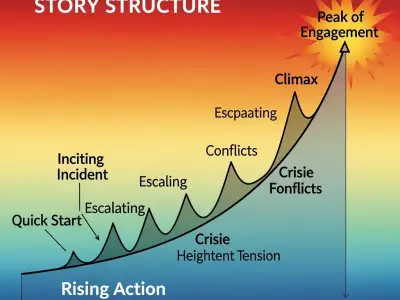If you've found yourself searching for a way to enhance your study or work sessions, the chances are that you've come across the Pomodoro Technique. This time management method, named after a tomato-shaped kitchen timer, has gained widespread popularity for its simplicity and effectiveness.
But what exactly is the Pomodoro Technique, and how can it transform your productivity? Let's explore the technique's essence, benefits, and steps to master it, ensuring you make the most of your learning and working sessions.
Jump to:
- What is the Pomodoro Technique?
- Why is Pomodoro So Effective?
- Is the Pomodoro Technique Scientifically Backed?
- The 5 Steps in the Pomodoro Technique
- What is the Best Time for Pomodoro?
- Addressing Common Concerns
- Mastering the Technique
- Integrating Pomodoro into Your Learning
- The Psychology Behind Pomodoro
- The Pomodoro Technique and Well-being
- Alternatives to Pomodoro
- Frequently Asked Questions About the Pomodoro Technique
What is the Pomodoro Technique?

The Pomodoro Technique is a time management method developed by Francesco Cirillo in the late 1980s. It breaks work into intervals, traditionally 25 minutes long, separated by short breaks. Each interval is known as a "Pomodoro," the Italian word for tomato, inspired by the tomato-shaped kitchen timer Cirillo used as a university student.
Why is Pomodoro So Effective?
The effectiveness of the Pomodoro Technique lies in its simplicity and the psychological benefits of taking regular breaks. This method helps to avoid burnout, keeps the mind fresh, and maintains a high level of productivity throughout a work or study session.
Is the Pomodoro Technique Scientifically Backed?
While the Pomodoro Technique is based on practical observations rather than scientific research, its principles align with studies on productivity and focus. Regular breaks have been shown to improve mental agility and sustained concentration.
The 5 Steps in the Pomodoro Technique

- Choose a Task: Begin by selecting a task or series of tasks to work on.
- Set the Pomodoro Timer: Use a timer to count down 25 minutes of focused work time.
- Work on the Task: Dedicate your full attention to the task until the timer rings.
- Take a Short Break: Once the Pomodoro is complete, take a short break (5 minutes is standard) to recharge.
- Repeat and Take Longer Breaks: After completing four Pomodoros, take a longer break (15-30 minutes) to reset.
What is the Best Time for Pomodoro?
The best time for a Pomodoro session depends on your schedule and when you feel most productive. Some find mornings ideal, while others prefer afternoons or evenings. The key is consistency and adapting the method to fit your lifestyle.
Addressing Common Concerns
- Preventing Burnout: Regular breaks within the Pomodoro framework can help prevent burnout by ensuring rest periods throughout the workday.
- Disruption of Flow: To prevent disrupting flow, try extending the length of your Pomodoros for tasks that require deep focus.
- Daily Pomodoros: The number of Pomodoros a person can do in a day varies. Listen to your body and mind, and don't push beyond your productive limits.
- Completing Tasks Early: If you finish a task early, use the remaining time for a quick review, planning the next steps, or a brief, mindful pause before the next Pomodoro.
- Reading on Breaks: Light reading can be a relaxing activity during breaks, as long as it feels like a genuine break from work.
Mastering the Technique

Consistency is key to mastering the Pomodoro Technique. Experiment with the length of your Pomodoros and breaks to find what best suits your workflow. Use a dedicated Pomodoro timer or app like Pomofocus to track your sessions. The goal is to find a rhythm that enhances your productivity without feeling rigid or constrained.
Integrating Pomodoro into Your Learning
Whether you're studying, working on a project, or earning a new skill, integrating the Pomodoro Technique can dramatically improve your focus and efficiency. Here are a few tips to seamlessly adopt this method into your routine:
- Start Small: Begin with one or two Pomodoros a day and gradually increase as you become more comfortable with the technique.
- Customise Your Breaks: Engage in activities that genuinely refresh you during breaks. Whether it's a brisk walk, stretching, or simply enjoying a cup of tea, find what helps you recharge.
- Use the Right Tools: A reliable Pomodoro timer is essential. Choose from various digital apps or a traditional kitchen timer to keep you on track.
- Track Your Progress: Keep a log of completed Pomodoros to monitor your productivity over time. This can also help estimate how much effort tasks require, aiding in better planning and time management.
The Psychology Behind Pomodoro
Understanding the psychological underpinnings of the Pomodoro Technique can enhance its effectiveness. The method leverages the idea of "reward"—the break—to motivate task completion. It also helps break down large, overwhelming tasks into manageable segments, reducing procrastination. Furthermore, regular breaks align with your brain's natural attention span, helping maintain high levels of concentration and preventing mental fatigue.
The Pomodoro Technique and Well-being
While the primary aim of the Pomodoro Technique is to enhance productivity, it also significantly benefits overall well-being. Regular breaks can reduce stress, prevent burnout, and promote a healthier work-life balance. By encouraging you to step away from your work and take meaningful pauses, the technique ensures that productivity doesn't come at the expense of your health.
Alternatives to Pomodoro
While the Pomodoro Technique works wonders for many, it's not a one-size-fits-all solution. Alternatives like the 52-17 method (52 minutes of work followed by 17 minutes of break) or time blocking may suit those who need longer periods of focus.
Frequently Asked Questions About the Pomodoro Technique
Does the Pomodoro Technique Help with ADHD?
Many people with ADHD find the Pomodoro Technique helpful. Its structured time frames encourage focus and provide regular breaks, aiding in managing attention and reducing the overwhelm often associated with time management.
What is the Pomodoro Learning Strategy’s Drawback?
One potential drawback of the Pomodoro Technique is its rigidity. Some tasks may require longer uninterrupted periods to reach a state of "flow" or deep work, where productivity peaks. However, this can often be mitigated by adjusting the length of the Pomodoros and breaks to fit individual needs.
Can the Pomodoro Technique Improve Quality of Work?
By encouraging periods of focused attention and regular breaks, the Pomodoro Technique can significantly enhance the quality of work. The method encourages you to concentrate on tasks with full engagement, leading to more thoughtful, high-quality outcomes.
How Can You Adjust Pomodoro Duration for Different Tasks?
Flexibility is a key strength of the Pomodoro Technique. For tasks that require deep concentration or longer workflows, you may extend the duration of a Pomodoro to 45 or even 50 minutes, followed by longer breaks. Experiment with durations to find the perfect balance that suits your work style and task demands.
Can the Pomodoro Technique be Used in Group Settings?
The Pomodoro Technique can be effectively implemented in group settings. By encouraging team members to synchronise work sessions, this collective approach can boost motivation, foster a sense of unity, and enhance productivity.
How Can You Handle Interruptions During a Pomodoro?
Interruptions are inevitable, but handling them efficiently can minimise their impact. If an interruption occurs, note it down quickly and return to it after your Pomodoro session. For urgent interruptions, consider shortening your Pomodoro to address the interruption and then resume your session.
Is the Pomodoro Technique Suitable for All Types of Work?
The Pomodoro Technique is versatile and can be adapted to suit a wide range of tasks. However, its effectiveness may vary depending on the nature of the work. For creative tasks that require uninterrupted flow, adjusting the length of Pomodoros or integrating other productivity methods might be beneficial.
How Can You Track Progress with the Pomodoro Technique?
Keeping a log of your Pomodoros, including tasks completed and the number of sessions dedicated to each task, can provide valuable insights into your productivity patterns and help you plan more effectively.
Embrace the Pomodoro Technique with Centre of Excellence
At Centre of Excellence, we're committed to supporting your journey of personal and professional development. We're excited to present our How to be a Super Learner Course at no cost when you join our community. This course will equip you with strategies and insights to maximise your learning potential and achieve your aspirations.
Why Centre of Excellence?
- Accessibility: We believe that everyone deserves access to high-quality education. Our courses are priced with inclusivity in mind, ensuring that learning is accessible to all.
- Flexibility: Our learning platform is designed to fit seamlessly into your life, allowing you to learn at your own pace and on your own terms.
- Diverse Range of Courses: Our curriculum spans a wide array of topics, from productivity strategies like the Pomodoro Technique to comprehensive courses on personal development, health, business, and much more.
- Supportive Learning Environment: By enrolling with us, you'll gain access to dedicated tutor support and become part of a vibrant community of learners.
Special Offer
We're delighted to offer an exclusive opportunity to join our How to be a Super Learner Course for free. This invitation is part of our commitment to enriching your learning experience and providing you with the tools and knowledge to thrive.




